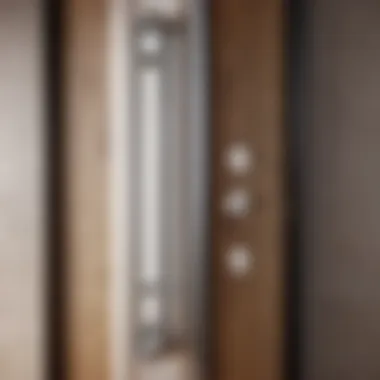Unlocking the Cost: A Detailed Guide on Replacing Your Bathroom Door


Materials:
When it comes to replacing a bathroom door, it is essential to gather all the necessary materials beforehand. Here is a comprehensive list of materials required for this DIY project:
- New bathroom door of desired material and style (ensure correct measurements to fit the door frame)
- Hinges and screws for attaching the door to the frame
- Door handle and lock mechanism (if not already included with the door)
- Screwdriver and drill for installation
- Measuring tape to ensure precise dimensions
- Sandpaper for smoothing any rough edges
- Paint and primer for finishing touches
DIY Steps:
Replacing a bathroom door can seem like a daunting task, but with the right guidance, it can be a manageable project. Follow these detailed instructions to successfully replace your bathroom door:
- Start by measuring the dimensions of your existing door and frame to purchase a new door that fits perfectly.
- Remove the old door by unscrewing the hinges and carefully detaching it from the frame.
- Install the new hinges on the door and align them with the frame, ensuring they are securely attached.
- Attach the door handle and lock mechanism according to the manufacturer's instructions.
- Place the new door into the frame and adjust it for proper alignment.
- Secure the door in place with screws and test the functionality of the handle and lock.
- Finish the door with paint and primer for a polished look.
Technical Aspects:
To ensure a successful bathroom door replacement, make sure to consider the following technical aspects:
- Use a level to ensure the door is hung straight and does not bind or rub against the frame.
- Timing-wise, allocate a few hours for this project to account for measurements, installation, and finishing touches.
- Critical techniques include checking the swing direction of the door and adjusting the hinges accordingly for proper function.
DIY Project Process:
The sequential steps involved in replacing a bathroom door are crucial for a smooth and efficient project:
- Measure twice, cut (or purchase) once to avoid any sizing errors.
- Lubricate hinges and locks to prevent squeaking and ensure smooth operation.
- Verify that the door swings open and closes without any obstructions.
Troubleshooting Tips:
In case you encounter common issues during the replacement process, here are some troubleshooting tips:
- If the door sticks or does not close properly, check the alignment and adjust the hinges as needed.
- For squeaky hinges, apply lubricant to reduce friction and noise.
By following these meticulous instructions and technical insights, you will successfully replace your bathroom door with precision and expertise.
Factors Affecting the Cost
When evaluating the cost of replacing a bathroom door, various factors come into play, each significantly impacting the overall expenses involved. Understanding these factors is crucial for homeowners looking to embark on this home improvement project. By delving into the materials, labor costs, and additional expenses involved, individuals can make informed decisions that align with their budget and quality expectations.


Materials
Solid Wood Doors
Solid wood doors are renowned for their timeless aesthetic appeal and durability. They add a touch of luxury and elegance to any space, making them a popular choice for homeowners seeking a classic look. The key characteristic of solid wood doors lies in their ability to be stained or painted to match any decor. While solid wood doors offer superior insulation and soundproofing, they can be relatively expensive compared to other door materials.
Hollow Core Doors
Hollow core doors are a budget-friendly option that prioritize practicality and cost-efficiency. Lightweight and easy to install, these doors are ideal for rooms where sound insulation is not a primary concern. The key characteristic of hollow core doors is their affordability and versatility in various design styles. However, they may lack the sturdiness and longevity of solid wood doors.
Fiberglass Doors
Fiberglass doors strike a balance between durability and aesthetics. Resistant to warping, cracking, and rotting, they are an excellent choice for high-moisture environments like bathrooms. The key characteristic of fiberglass doors is their low maintenance requirements and energy efficiency. While fiberglass doors may mimic the look of natural wood, some homeowners prefer the authentic feel of solid wood doors.
Glass Doors
Glass doors introduce an element of modernity and openness to a bathroom space. They reflect light, creating a bright and airy atmosphere. The key characteristic of glass doors is their ability to visually expand a room and complement contemporary design schemes. However, privacy concerns and maintenance requirements are aspects to consider when opting for glass doors.
Labor Costs
Installation Charges
Installation charges encompass the costs associated with fitting the new door in place. Whether hiring a professional or opting for DIY installation, labor costs are a significant part of the overall expenditure. The key characteristic of installation charges is their variability based on door type, size, and complexity. While professional installation ensures precision and efficiency, it adds to the total project cost.
Removal of Old Door
The removal of the old door involves labor-intensive processes such as dismantling, disposal, and preparation for the new door. This task requires careful handling to avoid damage to surrounding structures and finishes. The key characteristic of the removal of old doors is its necessity for ensuring a seamless door replacement process. DIY removal may save costs but could result in unforeseen complications.
Additional Repairs
In some cases, additional repairs may be needed before or during the door replacement process. This could include fixing damaged door frames, addressing structural issues, or reinforcing the installation area. The key characteristic of additional repairs is their impact on the overall project timeline and budget. Addressing these repairs proactively can prevent future issues and ensure the longevity of the new door.
Additional Expenses
Hardware and Accessories


Hardware and accessories such as hinges, doorknobs, and locks not only contribute to the functionality of the door but also enhance its aesthetic appeal. Choosing high-quality hardware ensures smooth operation and longevity for the entire door system. The key characteristic of hardware and accessories is their role in the overall door performance and security. Investing in durable hardware can prevent future replacements and maintenance costs.
Painting or Staining
Painting or staining the new door is a crucial step in the replacement process, enhancing its appearance and protecting it from the elements. The choice between painting and staining depends on personal preference and desired aesthetic outcomes. The key characteristic of painting or staining is their ability to customize the door's look to suit the overall design theme of the bathroom. Proper surface preparation and quality paint/stain selection contribute to a lasting finish.
Permit Costs
Obtaining permits for door replacement may be necessary depending on local building codes and regulations. Permit costs cover the administrative expenses associated with legal compliance and inspections. The key characteristic of permit costs is their role in ensuring that the door replacement meets safety and quality standards set by authorities. Ignoring permit requirements can lead to fines and project delays.
Average Cost Ranges
When considering the cost of replacing a bathroom door, it is essential to understand the different average cost ranges that homeowners may encounter. This section provides insight into the various price points involved in this home improvement project. By exploring low-end options, mid-range choices, and high-end alternatives, individuals can make informed decisions based on their budget and desired outcome.
Low-End Options
Low-end options for replacing a bathroom door typically revolve around basic material and installation costs. These cost-effective solutions cater to individuals looking for a budget-friendly yet functional upgrade to their bathroom doors.
Basic Material and Installation Costs
Basic material and installation costs are fundamental aspects to consider when opting for low-end options. By focusing on simpler door materials and standard installation procedures, homeowners can achieve a cost-effective replacement without compromising on quality. The affordability of basic materials like standard wood or composite doors, paired with straightforward installation requirements, makes this option appealing for those aiming to stick to a tight budget.
Mid-Range Choices
For individuals seeking a balance between cost and quality, mid-range choices offer a middle ground in the spectrum of bathroom door replacements. This section delves into higher-quality materials and skilled labor that contribute to a more durable and aesthetically pleasing outcome.
Higher-Quality Materials and Skilled Labor
Mid-range choices emphasize the use of higher-quality materials such as solid wood or fiberglass doors, accompanied by skilled labor for installation. This combination ensures a more robust and visually appealing door replacement, addressing both durability and aesthetics. Homeowners looking to invest a bit more in their bathroom doors can benefit from the longevity and enhanced appearance provided by these materials and labor expertise.
High-End Alternatives
Those with a higher budget or a penchant for luxury may opt for high-end alternatives when replacing their bathroom doors. Custom designs and premium finishes are key features in this category, elevating the overall look and feel of the bathroom.
Custom Designs and Premium Finishes


High-end alternatives offer customizable designs and premium finishes that cater to individual preferences and style tastes. From intricate door designs to luxurious finishes like glass etching or specialized coatings, these options add a unique and sophisticated touch to the bathroom decor. While the cost may be higher, the exclusivity and high-end appeal of custom designs and premium finishes make them a desirable choice for homeowners seeking a truly personalized and upscale door replacement.
Ways to Save on Costs
When delving into the cost implications of replacing a bathroom door, it is imperative to consider various strategies to minimize expenses and maximize value. Understanding ways to save on costs not only empowers homeowners but also ensures a practical approach to home improvement projects. In this section, we will explore key methods that can help individuals make economical choices without compromising quality or aesthetics.
DIY Installation
Risks and Benefits
The concept of DIY installation presents a compelling opportunity for individuals seeking cost-effective solutions. By opting to install the bathroom door themselves, homeowners can potentially save on labor costs associated with professional installation services. However, it is essential to acknowledge the risks and benefits inherent in DIY projects. One key advantage of DIY installation is the sense of accomplishment and personalization it offers, allowing homeowners to engage directly in the renovation process. On the other hand, potential drawbacks include the need for time, skill, and expertise to ensure a successful outcome. Understanding the balance between risks and benefits is crucial in determining whether DIY installation aligns with the overall goals of the project.
Comparing Multiple Quotes
Negotiating with Contractors
When comparing multiple quotes for bathroom door replacement, one of the critical aspects is negotiating with contractors. Effective negotiation can lead to cost savings and favorable terms, translating to a more budget-friendly project. By engaging in discussions with contractors and seeking competitive rates, homeowners can leverage different quotes to their advantage. Negotiating not only pertains to price but also to the scope of work, timelines, and additional services included in the contractor's proposal. Understanding how to negotiate effectively empowers individuals to make informed decisions and secure the best possible deal for their bathroom door replacement project.
Choosing Cost-Effective Materials
Durability vs. Price
A pivotal consideration when looking to save on costs is the selection of cost-effective materials that strike a balance between durability and price. While opting for budget-friendly materials can reduce upfront expenses, it is essential to evaluate their longevity and quality. Assessing the durability of materials in relation to their cost can help homeowners make informed choices that align with their budget constraints and long-term expectations. By weighing the advantages and disadvantages of various material options, individuals can prioritize durability without overspending, ensuring a cost-effective yet sustainable approach to bathroom door replacement.
Conclusion
In the world of home improvement projects, the conclusion is a vital aspect of ensuring that every detail has been meticulously considered and executed. In the case of replacing a bathroom door, the process culminates in the final considerations that bring together all elements of style, functionality, and financial prudence.
Balancing quality and budget becomes the focal point at this stage, where decisions need to be made regarding the materials, labor costs, and additional expenses. It is essential to strike a harmonious equilibrium between the desire for top-notch quality and the need to adhere to a predefined budget. This balancing act requires a discerning eye and meticulous planning to achieve a satisfactory outcome.
The importance of this conclusion lies in its ability to encapsulate the entire journey of door replacement, from initial contemplation to the realization of a fresh, new bathroom aesthetic. By carefully weighing the choices within the constraints of budget limitations, homeowners can attain a sense of accomplishment and satisfaction in upgrading their living spaces without overspending.
Final Considerations
Balancing Quality and Budget
The notion of balancing quality and budget stands as a pivotal aspect in the context of replacing a bathroom door. This concept revolves around the careful consideration of material choices, labor expenses, and additional costs to ensure that the end result aligns with both aesthetic aspirations and financial constraints.
One key characteristic of balancing quality and budget is its intrinsic value in guiding homeowners towards making prudent decisions that offer the best of both worlds - superior quality without excessive expenditure. This approach is widely favored for its ability to transform a simple door replacement project into a judicious investment in home enhancement.
An intriguing aspect of balancing quality and budget is the opportunity it presents for creative problem-solving and resource optimization. By carefully navigating the landscape of available materials and cost-effective solutions, individuals can leverage this juxtaposition to their advantage, achieving a desirable outcome without compromising on either quality or budgetary considerations.







